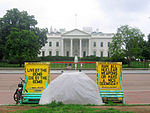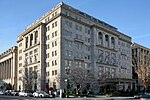Equestrian statue of Andrew Jackson (Washington, D.C.)
1852 sculpturesArtworks in the collection of the National Park ServiceBronze sculptures in Washington, D.C.Equestrian statues in LouisianaEquestrian statues in Tennessee ... and 8 more
Equestrian statues in Washington, D.C.Monuments and memorials in Washington, D.C.Northwest (Washington, D.C.)Outdoor sculptures in Washington, D.C.Sculptures of men in Washington, D.C.Statues of Andrew JacksonUse mdy dates from July 2020Vandalized works of art in Washington, D.C.

Andrew Jackson is a bronze equestrian statue by Clark Mills mounted on a white marble base in the center of Lafayette Square within President's Park in Washington, D.C., just to the north of the White House. Jackson is depicted dressed in military uniform, raising his hat with his right hand, while controlling the reins with his left hand as his horse rises on its rear legs.
Excerpt from the Wikipedia article Equestrian statue of Andrew Jackson (Washington, D.C.) (License: CC BY-SA 3.0, Authors, Images).Equestrian statue of Andrew Jackson (Washington, D.C.)
Pennsylvania Avenue Northwest, Washington
Geographical coordinates (GPS) Address External links Nearby Places Show on map
Geographical coordinates (GPS)
| Latitude | Longitude |
|---|---|
| N 38.89952 ° | E -77.03655 ° |
Address
Andrew Jackson
Pennsylvania Avenue Northwest
20006 Washington
District of Columbia, United States
Open on Google Maps








